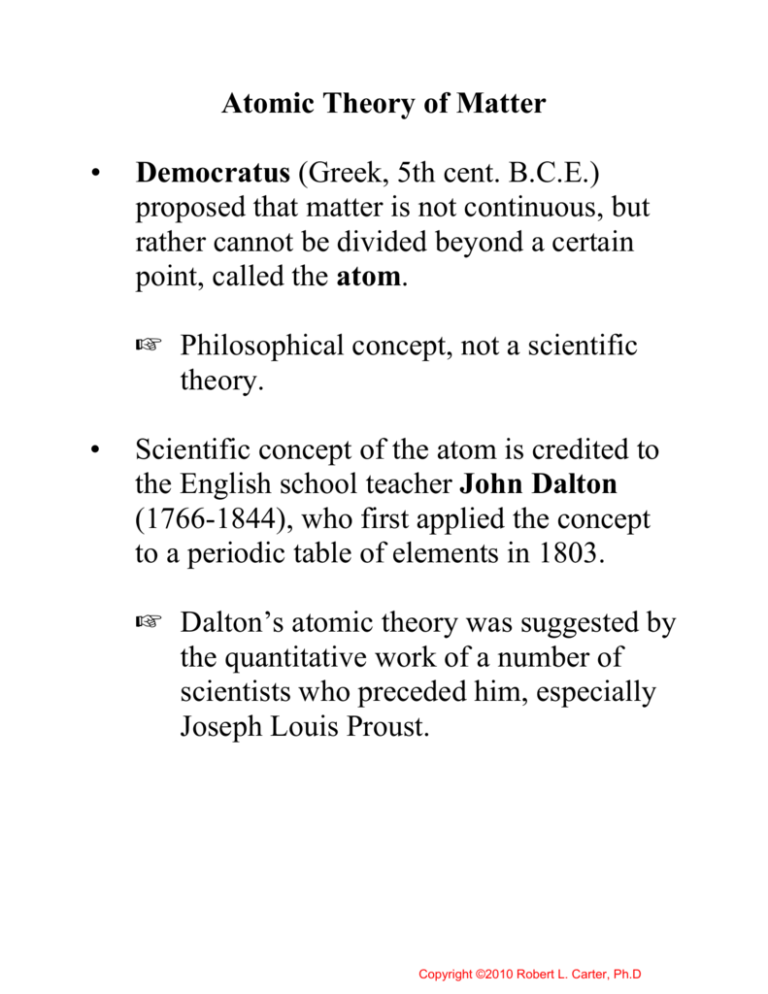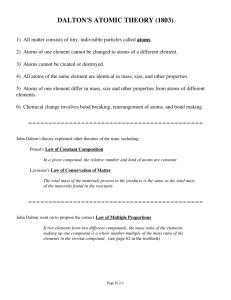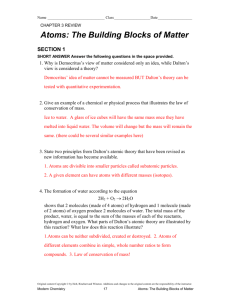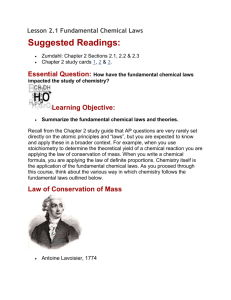Ch2ov1
advertisement

Atomic Theory of Matter
•
Democratus (Greek, 5th cent. B.C.E.)
proposed that matter is not continuous, but
rather cannot be divided beyond a certain
point, called the atom.
L Philosophical concept, not a scientific
theory.
•
Scientific concept of the atom is credited to
the English school teacher John Dalton
(1766-1844), who first applied the concept
to a periodic table of elements in 1803.
L Dalton’s atomic theory was suggested by
the quantitative work of a number of
scientists who preceded him, especially
Joseph Louis Proust.
Copyright ©2010 Robert L. Carter, Ph.D
Joseph Louis Proust
(1754 - 1826)
“We must recognize an invisible hand which
holds the balance in the formation of
compounds. A compound is a substance to
which Nature assigns fixed ratios; it is, in short,
a being which Nature never creates other than
balance in hand, pondere et mensurâ.”
– Proust, 1799
Copyright ©2010 Robert L. Carter, Ph.D
Law of Definite Proportions
or
Law of Constant Composition
A compound is always composed of the same
elements in a fixed ratio by weight.
Copyright ©2010 Robert L. Carter, Ph.D
Example: When 200.59 g of mercury reacts
completely with 32.066 g sulfur, 232.66 g of
red mercury sulfide is produced. What is the
percent composition by weight of red
mercury sulfide?
200.59 g
% Hg '
× 100% ' 86.216 % Hg
232.66 g
32.066 g
%S '
× 100% ' 13.782 % S
232.66 g
For every sample of red mercury sulfide the
same percent composition by weight is found.
(The mineral cinnabarite is this compound.) It
follows from this that a compound of mercury
and sulfur with any other percent composition
by weight must be a different substance.
Copyright ©2010 Robert L. Carter, Ph.D
Dalton's Atomic Theory (1803)
Î All matter is composed of atoms.
Ù All atoms of an element have the same mass
(atomic weight).
Ú All atoms of different elements have
different masses (i.e., different atomic
weights).
Û Atoms are indestructible and indivisible.
Ò Compounds are formed when atoms of two
or more elements combine.
Ó In a compound the relative numbers and
kinds of atoms are constant.
Copyright ©2010 Robert L. Carter, Ph.D
Modern Corrections to Dalton's Theory
Ï Many elements are composed of a mixture
of isotopes, atoms of the same element
with different masses.
Ð Some atoms of two different elements may
have virtually the same mass; these are
called isobars.
Ñ Atoms can be split (fission) or merged
(fusion) in nuclear reactions. Some of the
mass of atoms is converted to energy in
nuclear reactions, according to E = mc2.
Copyright ©2010 Robert L. Carter, Ph.D
Law of Multiple Proportions
If two elements can form more than one
compound, then the ratios of the weights of
one element in the compounds to a fixed
weight of the other element in the
compounds are small whole numbers.
—John Dalton, 1803
Copyright ©2010 Robert L. Carter, Ph.D
Example: In addition to red cinnabarite,
mercury and sulfur form a black compound.
When 32.066 g of sulfur reacts completely with
401.18 g of mercury, 433.25 g of black mercury
sulfide are produced. Show that the red and
black forms of mercury sulfide obey the Law of
Multiple Proportions.
Ratio Hg/S (black) =
401.18 g Hg/ 32.066 g S = 12.511 g Hg/g S
Ratio Hg/S (red) =
200.59 g Hg/32.066 g S = 6.2555 g Hg/g S
{Ratio Hg/S (black)}/{Ratio Hg/S (red)} =
12.511/6.2555 = 2
Copyright ©2010 Robert L. Carter, Ph.D








